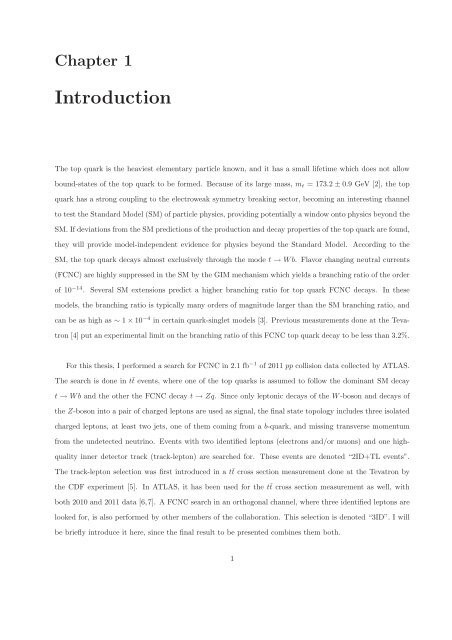CERN-THESIS-2012-153 26/07/2012 - CERN Document Server
CERN-THESIS-2012-153 26/07/2012 - CERN Document Server
CERN-THESIS-2012-153 26/07/2012 - CERN Document Server
You also want an ePaper? Increase the reach of your titles
YUMPU automatically turns print PDFs into web optimized ePapers that Google loves.
Chapter 1<br />
Introduction<br />
The top quark is the heaviest elementary particle known, and it has a small lifetime which does not allow<br />
bound-states of the top quark to be formed. Because of its large mass, mt = 173.2 ± 0.9 GeV [2], the top<br />
quark has a strong coupling to the electroweak symmetry breaking sector, becoming an interesting channel<br />
to test the Standard Model (SM) of particle physics, providing potentially a window onto physics beyond the<br />
SM. If deviations from the SM predictions of the production and decay properties of the top quark are found,<br />
they will provide model-independent evidence for physics beyond the Standard Model. According to the<br />
SM, the top quark decays almost exclusively through the mode t → Wb. Flavor changing neutral currents<br />
(FCNC) are highly suppressed in the SM by the GIM mechanism which yields a branching ratio of the order<br />
of 10 −14 . Several SM extensions predict a higher branching ratio for top quark FCNC decays. In these<br />
models, the branching ratio is typically many orders of magnitude larger than the SM branching ratio, and<br />
can be as high as ∼ 1 × 10 −4 in certain quark-singlet models [3]. Previous measurements done at the Teva-<br />
tron [4] put an experimental limit on the branching ratio of this FCNC top quark decay to be less than 3.2%.<br />
For this thesis, I performed a search for FCNC in 2.1 fb −1 of 2011 pp collision data collected by ATLAS.<br />
The search is done in t¯t events, where one of the top quarks is assumed to follow the dominant SM decay<br />
t → Wb and the other the FCNC decay t → Zq. Since only leptonic decays of the W-boson and decays of<br />
the Z-boson into a pair of charged leptons are used as signal, the final state topology includes three isolated<br />
charged leptons, at least two jets, one of them coming from a b-quark, and missing transverse momentum<br />
from the undetected neutrino. Events with two identified leptons (electrons and/or muons) and one high-<br />
quality inner detector track (track-lepton) are searched for. These events are denoted “2ID+TL events”.<br />
The track-lepton selection was first introduced in a t¯t cross section measurement done at the Tevatron by<br />
the CDF experiment [5]. In ATLAS, it has been used for the t¯t cross section measurement as well, with<br />
both 2010 and 2011 data [6,7]. A FCNC search in an orthogonal channel, where three identified leptons are<br />
looked for, is also performed by other members of the collaboration. This selection is denoted “3ID”. I will<br />
be briefly introduce it here, since the final result to be presented combines them both.<br />
1















